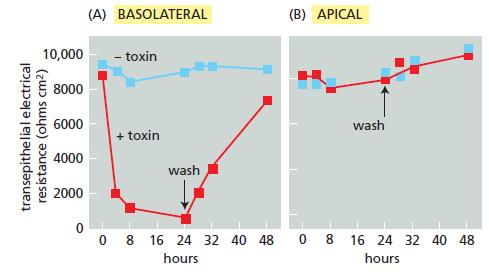The food-poisoning bacterium Clostridium perfringens makes a toxin that binds to members of the claudin family of
Question:
The food-poisoning bacterium Clostridium perfringens makes a toxin that binds to members of the claudin family of proteins, which are the main constituents of tight junctions. When the C-terminus of the toxin is bound to a claudin, the N-terminus can insert into the adjacent cell membrane, forming holes that kill the cell. The portion of the toxin that binds to the claudins has proven to be a valuable reagent for investigating the properties of tight junctions. MDCK cells are a common choice for studies of tight junctions because they can form an intact epithelial sheet with high transepithelial resistance. MDCK cells express two claudins: claudin-1, which is not bound by the toxin, and claudin-4, which is.
When an intact MDCK epithelial sheet is incubated with the C-terminal toxin fragment, claudin-4 disappears, becoming undetectable within 24 hours. In the absence of claudin-4, the cells remain healthy and the epithelial sheet appears intact. The mean number of strands in the tight junctions that link the cells also decreases over 24 hours from about four to about two, and they are less highly branched. A functional assay for the integrity of the tight junctions shows that transepithelial resistance decreases dramatically in the presence of the toxin, but the resistance can be restored by washing out the toxin (Figure Q19–2A). Curiously, the toxin produces these effects only when it is added to the basolateral side of the sheet; it has no effect when added to the apical surface (Figure Q19–2B).
A. How can it be that two tight-junction strands remain, even though all of the claudin-4 has disappeared?
B. Why do you suppose the toxin works when it is added to the basolateral side of the epithelial sheet, but not when added to the apical side?
Figure Q19-2

Step by Step Answer:

Molecular Biology Of The Cell
ISBN: 9780815344322
6th Edition
Authors: Bruce Alberts, Alexander D. Johnson, Julian Lewis, David Morgan, Martin Raff, Keith Roberts, Peter Walter




